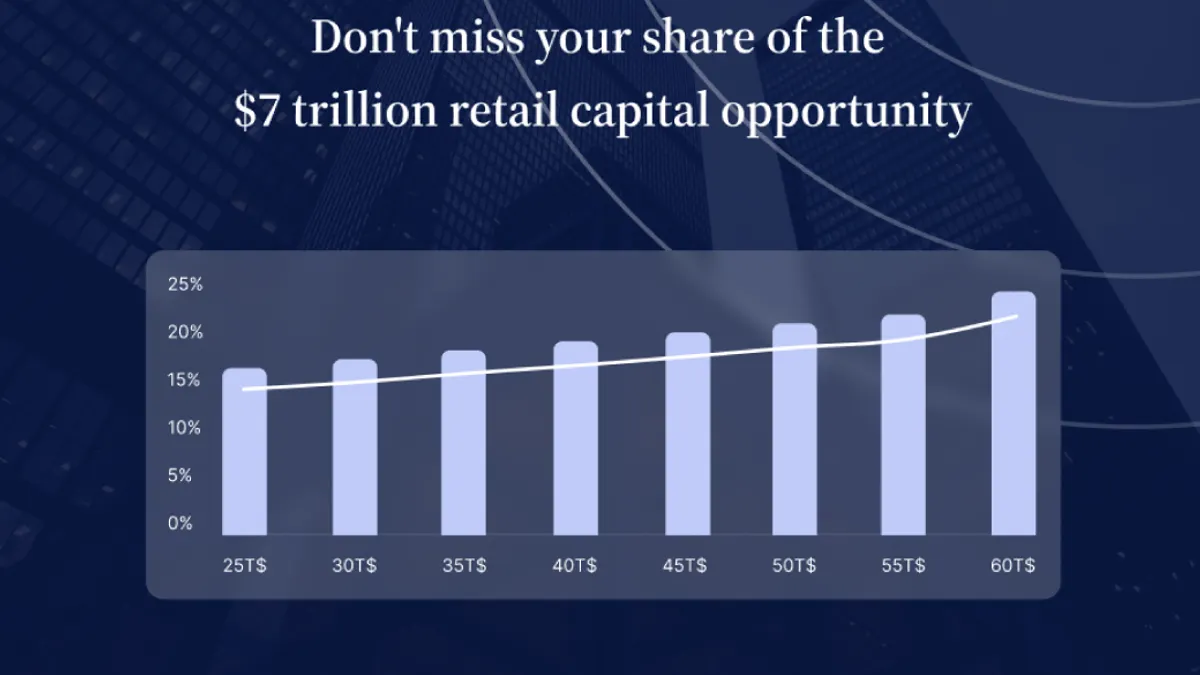Private markets are experiencing their biggest transformation in decades, driven by a fundamental shift in where capital is coming from. While most firms remain focused on traditional institutional fundraising, the data shows a different reality: $7 trillion in retail capital is entering alternatives through 2032, but only firms that understand how to connect with retail investors will capture their share.
The numbers paint a clear picture. JPMorgan research confirms that engagement in brokerage accounts and capital deployment hit record highs by 2022, with the share of U.S. households holding stock investments reaching 58%, up from 53% in 2001. Meanwhile, institutional investors like pensions and endowments have largely reached their allocation limits to alternatives.
Private market investments have grown to approximately $25 trillion in assets under management and are projected to more than double to approximately $60 trillion by 2032. Retail investors are expected to drive much of this growth, with their share of alternative AUM rising from approximately 16% in 2022 to approximately 22% by 2032.
The challenge is execution. Retail investors expect completely different approaches than institutional LPs. While institutional fundraising has well-established playbooks, retail investors demand real-time data access, streamlined onboarding and transparent communication that many mid-sized firms haven't yet implemented.
Mid-sized GPs have a documented advantage in this market. Industry reports show smaller and mid-market funds have demonstrated stronger momentum with retail investors than mega-funds in recent years. Personal relationships and trust often matter more to retail investors than firm size or brand name. A typical high-net-worth individual might commit $50,000-$250,000 motivated by tax advantages and passive income, but they also expect personal attention and regular updates from the sponsor.
A Brookfield-Oaktree Wealth Solutions Survey found that 70% of high-net-worth individuals would invest in alternatives if properly approached, with many showing openness to boutique and mid-sized managers when proper alignment exists. This represents a massive untapped market for GPs who understand retail investor expectations.
However, the competitive landscape is changing rapidly. Major financial institutions are increasingly targeting retail investors, developing sophisticated platforms and products specifically for this market. BlackRock, KKR, Apollo and Goldman Sachs have all launched new private-market funds targeting individual investors. As these mega-firms adapt their strategies, the advantages available to mid-sized firms today will not persist indefinitely.
Success requires understanding what retail investors actually want. They expect institutional-grade technology with consumer-friendly interfaces. They want education about alternative investments, not just pitch decks. They demand transparency throughout the investment lifecycle, not quarterly PDF reports.
The firms that develop these capabilities will access new capital sources, diversify their investor base and build scalable acquisition systems while their competitors remain dependent on traditional institutional channels. Those that wait will find themselves competing for an increasingly smaller pool of institutional capital.
The data shows this shift is accelerating. Interest rates are stabilizing, individuals are eager to participate in alternatives, and technology is enabling connections between GPs and investors at scale. For mid-sized sponsors, this is the moment to establish position in the retail investor market before the opportunity becomes saturated with institutional competition.
Get your copy of the Retail Investor Capital Guide to discover the specific strategies, operational requirements and technology solutions needed to capture your share of the expanding retail capital market before your competitors adapt.
Download the complete guide: "How to Capture Retail Investor Capital: A Guide for Mid-Sized GPs"








